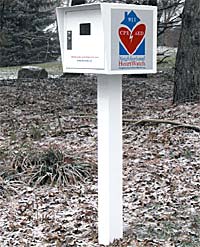AED use at home has minimal risk
‘Keep the Beat’ campaign this summer with singer-songwriter James Taylor is raising funds to place AEDs in schools.
Automatic external defibrillators should become as common as fire extinguishers, according to Douglas Zipes, MD.
“Such a development would absolutely be a positive one. Is it cost-effective? Probably not, but neither is your smoke alarm or your carbon monoxide alarm or the airbag in your car and so forth,” Zipes said.
“None of these are cost effective because it is unlikely they will be used. That’s a good thing, but when you do need it, it will be there. With AEDs and sudden cardiac arrest, we’re talking about three to five minutes before brain death.”
|
|
No experience needed
The devices present little risk and are simple to use. “Basically you just listen and follow the directions,” Zipes said. One study conducted at Chicago O’Hare International Airport found that half of the people had been resuscitated with an AED operated by someone who had not previously seen the device.
Zipes said the Neighborhood Heart Watch nonprofit program is partnering this summer with AED manufacturer Medtronic and singer-songwriter James Taylor in a campaign called Keep the Beat that will educate people about sudden cardiac arrest and AED use and will raise funds to place the devices in schools.
Taylor will highlight AED use during his 33-city Summer’s Here tour. Funds raised from the effort will be donated to Neighborhood Heart Watch to purchase AEDs for schools. Schools across the country can apply for a grant from the Neighborhood Heart Watch to receive a free AED, training in its use and direction in implementing a program, according to a Medtronic press release. American Medical Response, a private medical transportation company, will donate training to all schools that are given AEDs.
|
|
“I went to a James Taylor concert in Dallas to meet with him and discuss this. He is a very serious and committed individual to this cause. His father is a physician, and this will be a very big campaign,” Zipes said.
Make devices accessible
Physicians should recommend home AEDs to their patients aged 40 and older or at an earlier age if the patient has heart disease, said Zipes, distinguished professor of medicine at the Indiana University School of Medicine and section editor of Cardiology Today’s Electrophysiology and Arrhythmia Disorders section.
Home AEDs cost about $1,500, too expensive for some families. Establishing a Neighborhood Heart Watch program can help defray the cost because the cost of an AED is shared among a group of residents in an area. Each resident is given a key to access the device and instructions on how to use it.
Home use of an AED is nearly foolproof, but individuals considering purchasing them should be advised of the emotional responsibility that comes with the equipment. “If you are empowered with the obligation of saving a spouse, that becomes a very difficult emotional issue. When do you go to sleep? When does the spouse go to the bathroom? When do you go shopping? Family members need to decide how much of a 24-7 responsibility they are willing to take on,” Zipes said. – by Jeremy Moore


